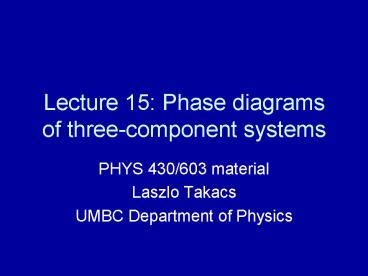Lecture 15: Phase diagrams of three-component systems - PowerPoint PPT Presentation
Title:
Lecture 15: Phase diagrams of three-component systems
Description:
Lecture 15: Phase diagrams of three-component systems PHYS 430/603 material Laszlo Takacs UMBC Department of Physics How to read concentrations from a triangular ... – PowerPoint PPT presentation
Number of Views:215
Avg rating:3.0/5.0
Title: Lecture 15: Phase diagrams of three-component systems
1
Lecture 15 Phase diagrams of three-component
systems
- PHYS 430/603 material
- Laszlo Takacs
- UMBC Department of Physics
2
How to read concentrations from a triangular
phase diagram?cA 100 at point A, 0 along
the BC side, and has a constant value along any
line parallel to BC. If we draw a parallel to BC
through the point of interest (y) we can read the
concentration of A on either AB or AC.
3
It is also customary to use rectangular
coordinate axes for two components, especially if
those compositions are low. The diagrams can be
extended to 3-d to show temperature.
4
The Fe - Ni - Cr system
5
Application of the Gibbs phase rule
- f n - P 2, where
- f number of degrees of freedom (or freely
selectable parameters) - Temperature, pressure, composition of the
constituent phases - The average composition of a sample is NOT a
degree of freedom. - n number of chemical components
- Element or compound
- P number of phases
6
Single - component
- f n - P 2
- n 1
- Possible degrees of freedom T, p
- Inside an area, P 1 ? f 2. T and p can be
chosen freely. - On a line, 2 phases are in equilibrium, P 2 ? f
1. Either T or p can be chosen, but it fixes
the other variable. The relative amounts are not
determined by the phase diagram. - On an intersection of lines,
- 3 phases are in equilibrium,
- P 2 ? f 0. This is an invariant point
where the parameters are fixed. How much of each
phase is present is undetermined. - Four phases cannot be in equilibrium.
7
Two - component
- f n - P 2
- f n - P 1, if p is fixed.
- n 2
- Possible degrees of freedom
- T, p, c of constituent phases
- In a single-phase area, P 1
- ? f 2. T and c can be chosen freely.
- In a 2-phase area, P 2 ? f 1. If either T,
c1 or c2 is chosen, the others get fixed. (E.g.
choose c1, the composition of the Ag-based solid
solution. That determines T and the horizontal
line at that T determines the composition of the
Cu-based solution.) Relative quantities by lever
rule. - On the invariant line at the eutectic
temperature, 3 phases are in equilibrium, (Ag),
(Cu), L. - P 3 ? f 0. There is no free parameter here.
The invariant line can be pictured as a flattened
triangle containing a mix of all three phases.
With that in mind, any area is bordered by areas
with one more or one fewer phases.
8
(No Transcript)
9
Three - component
- f n - P 1
- n 3
- Inside an empty area, P 1
- ? f 3. T and two concentration can be chosen
freely (the third obviously follows.) - In a striped area, P 2 ?
- f 2. T and µ can be chosen freely. Instead of
the chemical potential, µ, the composition of one
component is usually chosen, The stripes are
tie lines that fix the composition of the other
phase. - In a shaded triangle, 3 phases are in
equilibrium, P 3 ? - f 1. Thus T can be chosen freely, but then
the vertices of the triangle determine the
concentration of each phase.
10
3-d representation and projection of the liquidus
surface of a 3-component eutectic
11
The Al2O3 - Fe2O3 - Fe system
12
Classification of granite and its relatives































